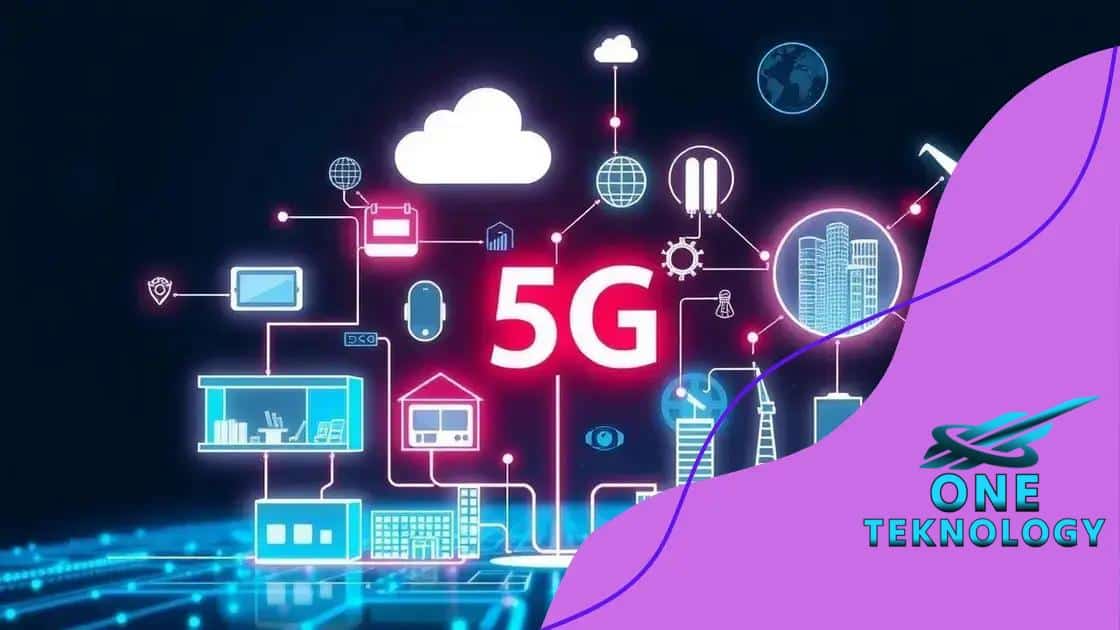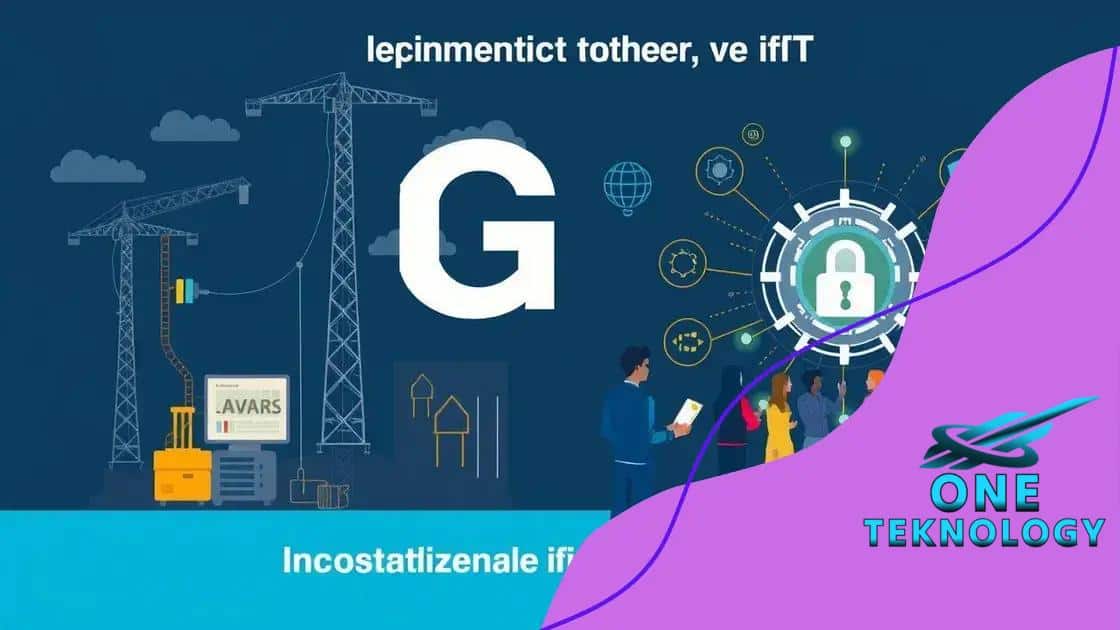The impact of 5G on Internet of Things (IoT) applications

The impact of 5G on Internet of Things (IoT) applications enhances connectivity, improves efficiency in various industries, and enables real-time data processing for smarter cities, healthcare, and automation solutions.
The impact of 5G on Internet of Things (IoT) applications is profound, as it connects devices in unprecedented ways. Have you ever considered how these advancements might shape your daily life?
Understanding 5G technology
To fully grasp the impact of 5G on Internet of Things (IoT) applications, it’s essential to understand what 5G technology is. It’s the fifth generation of mobile networks, designed to enhance speed, reduce latency, and connect more devices simultaneously.
This upgraded network improves the overall experience for users and devices alike. The significant part of 5G is its ability to transmit data at lightning speed. With speeds potentially exceeding 10 Gbps, individuals can enjoy seamless video streaming and quick downloads.
Key Features of 5G
5G brings exceptional features that revolutionize connectivity:
- Enhanced Speed: 5G networks are exponentially faster than their predecessors, making everything from video calls to gaming smoother.
- Lower Latency: The reduced delay in communication allows real-time interactions, critical for applications like remote surgery.
- Increased Capacity: 5G can connect up to one million devices per square kilometer, essential for smart cities.
Moreover, 5G’s architecture supports the emergence of advanced technologies such as augmented reality and machine learning. By combining these innovations, we can create smarter ecosystems where devices communicate more effectively.
How 5G Transforms IoT
The transition to 5G is a game-changer for IoT. With faster and more reliable internet, devices can share data in real-time, enhancing automation. Consider smart homes with connected appliances; they work better with quicker communication. A smart thermostat, for example, can adjust your home’s temperature based on user preferences and real-time weather updates.
As industries adopt 5G, this technology enables advanced applications like connected cars, where vehicles communicate with each other to enhance safety. For businesses, the combination of 5G and IoT can lead to significant efficiency gains and new service models. Overall, understanding 5G technology is crucial to harnessing its full potential in the rapidly evolving digital landscape. As we look to the future, the blend of 5G and IoT will undoubtedly reshape our world in ways we are only beginning to imagine.
Key benefits of 5G for IoT
The key benefits of 5G for IoT are transforming how industries operate and individuals interact with technology. With its advanced capabilities, 5G enables faster and more reliable connections between devices, leading to enhanced performance across various applications.
One major advantage is improved speed. 5G can deliver data at incredible rates, allowing IoT devices to communicate almost instantaneously. This speed is crucial for real-time data processing, essential in applications like autonomous vehicles and remote monitoring systems.
Enhanced Reliability
Alongside speed, 5G offers greater reliability. With fewer dropped connections, devices can maintain constant communication, which is vital for businesses that depend on continuous data flow. Imagine smart factories where machinery operates without interruptions.
- Low Latency: 5G has a remarkably low latency, reducing delays in data transmission and improving responsiveness for applications like telemedicine and gaming.
- Increased Device Density: 5G can support a massive number of connected devices. This factor is key for smart cities where thousands of sensors relay information almost simultaneously.
- Energy Efficiency: Devices connected via 5G networks can operate more efficiently, conserving battery life and reducing operational costs.
Another vital benefit is the ability to connect various devices into a unified network. This integration allows for smarter analytics and better decision-making. For instance, in agriculture, farmers can manage irrigation systems remotely, optimizing water usage based on real-time climate data.
5G also fosters innovation by enabling new technologies and services. The integration of augmented reality (AR) and virtual reality (VR) with 5G can lead to immersive educational experiences and new training methods. Businesses can leverage these technologies to enhance customer experiences, making interactions more engaging.
Overall, the key benefits of 5G for IoT are driving significant advancements across all sectors. As we continue to embrace these technologies, the potential for growth and innovation appears limitless.
Challenges in implementing 5G in IoT

While the implementation of 5G in IoT brings numerous benefits, it also presents several challenges that need careful consideration. These challenges can impact the rate and effectiveness of adopting this groundbreaking technology.
One significant hurdle is the cost associated with infrastructure development. Building new towers and upgrading existing networks requires substantial investment. This expense can deter smaller companies from committing to the transition.
Regulatory and Security Issues
Additionally, navigating regulatory hurdles is a complex process. Governments must establish guidelines that ensure safety and privacy while promoting innovation. These regulations can slow down deployment, causing delays in realizing the benefits of 5G.
- Security Concerns: 5G networks increase the attack surface for cyber threats, requiring stronger security measures to protect sensitive data.
- Interference with Existing Systems: Integrating new 5G infrastructure with older technologies may cause disruptions or compatibility issues.
- Physical Limitations: 5G signals have a shorter range compared to earlier generations. This limitation necessitates more base stations to maintain coverage.
Another challenge is the need for devices and sensors to support 5G technology. Many existing IoT devices were designed for earlier generations and may require upgrades or complete replacements. This situation adds to the overall cost of the transition.
Moreover, there is a skills gap in the workforce. Professionals skilled in 5G technologies are still in short supply. Companies may struggle to find qualified personnel to manage and maintain these new networks.
Finally, public acceptance and understanding of 5G technology can pose a barrier. Misinformation about health risks associated with 5G networks can create resistance among communities, hindering deployment efforts. Building trust and educating the public is vital for successful implementation.
Real-world applications of 5G in IoT
The real-world applications of 5G in IoT are paving the way for a more connected and efficient future. Various industries are already leveraging this technology to enhance operations and improve overall productivity.
One prominent example is in smart cities. Cities are using 5G to optimize traffic management. By connecting traffic lights and sensors, cities can respond to real-time traffic conditions, reducing congestion and improving air quality.
Healthcare Innovations
In the healthcare sector, 5G enables telemedicine. Doctors can use high-definition video to consult with patients remotely, which is especially valuable in rural areas. This technology also supports remote monitoring of patients with chronic illnesses, allowing healthcare providers to track health data in real-time.
- Connected Vehicles: Automotive companies are deploying 5G to facilitate communication between vehicles. This communication helps in avoiding collisions and improving road safety.
- Smart Agriculture: Farmers use 5G-enabled sensors to monitor soil moisture and crop health. This data helps optimize resource usage, increasing yields while minimizing waste.
- Industrial Automation: Factories are adopting 5G to connect machines and sensors, enabling predictive maintenance. This prevents downtime and enhances production efficiency.
Furthermore, 5G significantly boosts the development of the Internet of Things in homes. Smart appliances can communicate with each other, creating more energy-efficient households. For example, a smart thermostat can adjust the heating based on the homeowner’s schedule and preferences.
Another impressive application is in the realm of augmented reality (AR) and virtual reality (VR). With 5G, businesses can offer immersive experiences that enhance training and customer engagement. Imagine a retail store where customers can try products virtually without physical limitations.
In the entertainment industry, 5G facilitates the rapid streaming of ultra-high-definition content, improving user experiences for gaming and video streaming services. This capability allows for multiple devices to connect without lag, creating a seamless experience for users.
Future trends of 5G and IoT integration
The future trends of 5G and IoT integration promise to create a more connected world, where technology works seamlessly across various sectors. As we look ahead, several emerging trends signal the growth and transformation of this integration.
One key trend is the increased deployment of edge computing. With 5G, processing data closer to where it is generated becomes feasible. This shift decreases latency and improves response times for IoT devices, making applications more efficient.
Advancements in AI and Machine Learning
Another significant development is the fusion of 5G with artificial intelligence and machine learning. These technologies will enhance decision-making by analyzing vast amounts of data collected from IoT devices. Businesses can make more informed choices, optimizing operations based on real-time data.
- Expanded Connectivity: As 5G expands globally, more devices will be able to connect, creating a network of opportunities that can benefit various sectors, from healthcare to transportation.
- Smart Infrastructure: Cities will likely deploy 5G-powered IoT solutions to create smart infrastructures that improve resource management, such as energy use and waste disposal.
- Enhanced Security Features: Future developments will emphasize securing IoT devices connected to 5G networks, implementing advanced protocols that ensure safety and privacy.
Moreover, the trend toward autonomous systems will gain momentum. With 5G, self-driving cars and remote drones can communicate continuously with their environments. This connectivity enhances safety and efficiency, paving the way for smarter urban transport systems.
Healthcare applications will also evolve with 5G and IoT integration. Telemedicine will become more prevalent, with doctors accessing health data and providing real-time consultations remotely. This evolution allows for quicker diagnoses and better patient management.
In the entertainment sector, immersive experiences will expand as 5G enables high-speed streaming of virtual and augmented reality content. Users will enjoy seamless interactions in gaming and film experiences, fostering new forms of engagement.
Finally, the rise of sustainable technology solutions combined with 5G will lead to smarter energy management practices. IoT devices will assist in monitoring and optimizing energy consumption, contributing to environmental sustainability goals.
FAQ – Frequently Asked Questions about 5G and IoT Integration
What is the primary benefit of integrating 5G with IoT?
The primary benefit is enhanced connectivity, which allows devices to communicate faster and more reliably, improving overall efficiency.
How does 5G improve smart city management?
5G enables real-time data processing from various sensors, helping cities optimize traffic, reduce energy consumption, and enhance public services.
What challenges do businesses face when implementing 5G for IoT?
Challenges include high infrastructure costs, regulatory hurdles, and the need for enhanced security measures to protect data.
How will healthcare benefit from 5G and IoT integration?
Healthcare will benefit through improved telemedicine services, enabling real-time monitoring of patients and faster consultations with healthcare providers.






